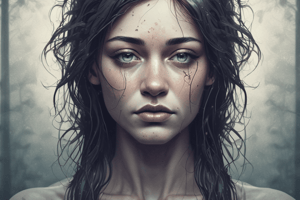Podcast
Questions and Answers
What distinguishes reactive depression from endogenous depression?
What distinguishes reactive depression from endogenous depression?
- Endogenous depression lasts less than 2 weeks.
- Reactive depression is triggered by a negative experience. (correct)
- Endogenous depression is triggered by a negative experience.
- Reactive depression has no apparent cause.
Which brain regions are notably involved in the reduction of grey matter in major depressive disorder?
Which brain regions are notably involved in the reduction of grey matter in major depressive disorder?
- Thalamus and striatum
- Prefrontal cortex and amygdala (correct)
- Brainstem and corpus callosum
- Cerebellum and occipital lobe
According to the monoamine theory of depression, what is mainly reduced in depressive disorders?
According to the monoamine theory of depression, what is mainly reduced in depressive disorders?
- Serotonin and noradrenaline activity (correct)
- Dopamine activity
- Glutamate levels
- Corticosteroid release
What does the neuroplasticity theory suggest about the onset of depression?
What does the neuroplasticity theory suggest about the onset of depression?
Which symptom is primarily associated with anhedonia in major depressive disorder?
Which symptom is primarily associated with anhedonia in major depressive disorder?
What is the role of BDNF in relation to depression?
What is the role of BDNF in relation to depression?
What characterizes hypomania in bipolar disorder?
What characterizes hypomania in bipolar disorder?
Which brain structure is reported to have a decreased volume in individuals with bipolar disorder?
Which brain structure is reported to have a decreased volume in individuals with bipolar disorder?
Which theory posits that the brain-reward system becomes dysfunctional in bipolar disorder?
Which theory posits that the brain-reward system becomes dysfunctional in bipolar disorder?
Panic disorders are characterized by which of the following symptoms?
Panic disorders are characterized by which of the following symptoms?
What differentiates anxiety disorders from major depressive disorders at the neural level?
What differentiates anxiety disorders from major depressive disorders at the neural level?
In Tourette's disorder, what role does the caudate nucleus play?
In Tourette's disorder, what role does the caudate nucleus play?
Which neurotransmitter imbalances are associated with anxiety disorders?
Which neurotransmitter imbalances are associated with anxiety disorders?
Which of these accurately describes the symptoms of motor tics in Tourette's disorder?
Which of these accurately describes the symptoms of motor tics in Tourette's disorder?
What distinguishes Bipolar I disorder from Bipolar II disorder?
What distinguishes Bipolar I disorder from Bipolar II disorder?
Flashcards are hidden until you start studying
Study Notes
Depressive Disorders
- Clinical depression, or major depressive disorder, lasts longer than two weeks.
- Two types: reactive depression (triggered by negative experiences) and endogenous depression (no apparent cause).
- Associated neural changes include reduced grey matter in the prefrontal cortex, hippocampus, amygdala, and cingulate cortex.
- White matter reduction is primarily observed in the frontal cortex.
- Atypical activity is seen in brain structures such as the frontal cortex and insular cortex.
- Anhedonia, characterized by the loss of pleasure without clear reason, is a significant symptom.
- Additional symptoms include sleep disturbances, suicidal thoughts, and difficulty meeting daily needs.
- Theories explaining depression include:
- Monoamine theory: Depressive disorders arise from reduced serotonin and noradrenaline activity.
- Neuroplasticity theory: Antidepressant effects occur over weeks, indicating changes in neuroplasticity processes leading to neuronal loss and reduced neurotrophin synthesis.
- Antidepressants enhance neurotrophin synthesis, synapse formation, and neurogenesis in the adult hippocampus.
- Brain-derived neurotrophic factor (BDNF) may serve as a biomarker for depression.
Bipolar Disorders
- Characterized by alternating episodes of depression and hypomania/mania.
- Hypomania involves high energy and reduced need for sleep, while mania includes extreme features and possible delusions.
- Bipolar I involves episodes of mania or hypomania in addition to depression; Bipolar II features depression with hypomania.
- Neural correlates show a reduction in overall grey matter volume and smaller sizes of specific brain structures like the medial prefrontal cortex and hippocampus.
- Atypical activation and connectivity occur in the frontal cortex and basal ganglia.
- Theories for bipolar disorder include:
- Dysfunction in hypothalamic-pituitary-adrenal axis.
- Disruption of circadian rhythms.
- Neurotransmission changes in GABA, glutamate, and dopamine.
- Low BDNF levels, similar to depressive disorders.
- Reward hypersensitivity, showing an overreaction to rewards leading to excessive goal seeking—a hallmark of mania.
Anxiety Disorders
- Defined by chronic fear without direct threats, often accompanied by physiological symptoms.
- Can motivate effective coping behaviors in non-disordered forms.
- Four main types of anxiety disorders:
- Generalized Anxiety Disorder (GAD): Extreme anxiety across multiple activities.
- Specific Phobias: Intense fear of specific objects or situations.
- Agoraphobia: Fear of public spaces leading to feelings of helplessness.
- Panic Disorders: Rapid onset of panic attacks and fear of future attacks.
- Neural bases involve GABA and serotonin deficits.
- Brain structures affected include the prefrontal cortex and amygdala, with atypical activity rather than atrophy observed in anxiety disorders.
Tourette’s Disorders
- Characterized by involuntary, repetitive tics—motor (movements) and vocal (sounds).
- Symptoms typically decrease with maturation.
- Neural correlates include a smaller striatum volume.
- Suppression of tics activates the prefrontal cortex and caudate nuclei, indicating impaired suppression of unwanted movements.
- Dysfunctional dopaminergic and GABAergic signaling affects habit formation circuits involving the cortex, striatum, and thalamus.
- Notable thinning of gray matter occurs in the sensory motor cortex area controlling facial and vocal expressions.
Studying That Suits You
Use AI to generate personalized quizzes and flashcards to suit your learning preferences.




